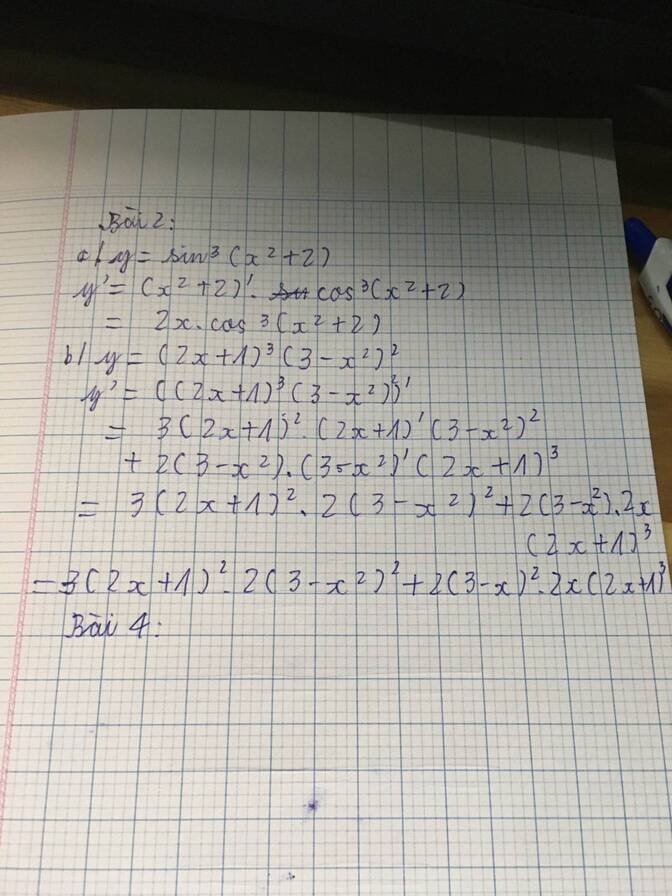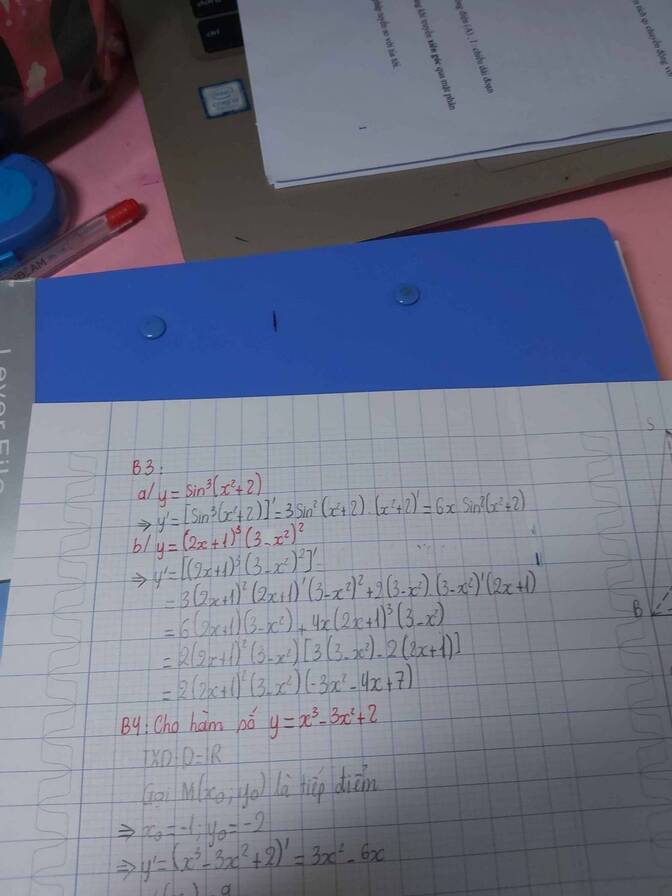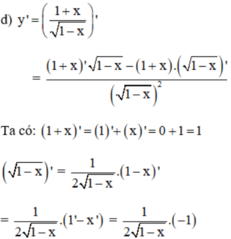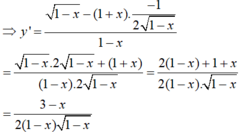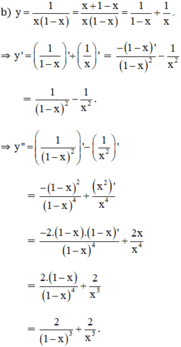Tính đạo hàm của các hàm số sau: y = x 3 a 2 - x 2 a là hằng số

Những câu hỏi liên quan
Tính đạo hàm của các hàm số sau: (2 điểm)
a. $y={{\sin }^{3}}\left( {{x}^{2}}+2 \right)$;
b. $y={{\left( 2x+1 \right)}^{3}}{{\left( 3-{{x}^{2}} \right)}^{2}}$.
https://drive.google.com/file/d/14Q-YI3szy-rePnIHWGD35RKCWiCXCT6k/view?usp=sharing
Đúng 0
Bình luận (0)
Xem thêm câu trả lời
1. Tính đạo hàm của các hàm số sau:a, ydfrac{2x-1}{x-1}b, ydfrac{2x+1}{1-3x}c, ydfrac{x^2+2x+2}{x+1}d, ydfrac{2x^2}{x^2-2x-3}e, yx+1-dfrac{2}{x-1}g, ydfrac{2x^2-4x+5}{2x+1}2. Tính đạo hàm của các hàm số sau:a, yleft(x^2+x+1right)^4b, y (1-2x2)5c, yleft(dfrac{2x+1}{x-1}right)^3d, ydfrac{left(x+1right)^2}{left(x-1right)^3}e, ydfrac{1}{left(x^2-2x+5right)^2}f, yleft(3-2x^2right)^4
Đọc tiếp
1. Tính đạo hàm của các hàm số sau:
a, \(y=\dfrac{2x-1}{x-1}\)
b, \(y=\dfrac{2x+1}{1-3x}\)
c, \(y=\dfrac{x^2+2x+2}{x+1}\)
d, \(y=\dfrac{2x^2}{x^2-2x-3}\)
e, \(y=x+1-\dfrac{2}{x-1}\)
g, \(y=\dfrac{2x^2-4x+5}{2x+1}\)
2. Tính đạo hàm của các hàm số sau:
a, \(y=\left(x^2+x+1\right)^4\)
b, y= (1-2x2)5
c, \(y=\left(\dfrac{2x+1}{x-1}\right)^3\)
d, \(y=\dfrac{\left(x+1\right)^2}{\left(x-1\right)^3}\)
e, \(y=\dfrac{1}{\left(x^2-2x+5\right)^2}\)
f, \(y=\left(3-2x^2\right)^4\)
a. \(y'=\dfrac{-1}{\left(x-1\right)}\)
b. \(y'=\dfrac{5}{\left(1-3x\right)^2}\)
c. \(y=\dfrac{\left(x+1\right)^2+1}{x+1}=x+1+\dfrac{1}{x+1}\Rightarrow y'=1-\dfrac{1}{\left(x+1\right)^2}=\dfrac{x^2+2x}{\left(x+1\right)^2}\)
d. \(y'=\dfrac{4x\left(x^2-2x-3\right)-2x^2\left(2x-2\right)}{\left(x^2-2x-3\right)^2}=\dfrac{-4x^2-12x}{\left(x^2-2x-3\right)^2}\)
e. \(y'=1+\dfrac{2}{\left(x-1\right)^2}=\dfrac{x^2-2x+3}{\left(x-1\right)^2}\)
g. \(y'=\dfrac{\left(4x-4\right)\left(2x+1\right)-2\left(2x^2-4x+5\right)}{\left(2x+1\right)^2}=\dfrac{4x^2+4x-14}{\left(2x+1\right)^2}\)
Đúng 1
Bình luận (0)
2.
a. \(y'=4\left(x^2+x+1\right)^3.\left(x^2+x+1\right)'=4\left(x^2+x+1\right)^3\left(2x+1\right)\)
b. \(y'=5\left(1-2x^2\right)^4.\left(1-2x^2\right)'=-20x\left(1-2x^2\right)^4\)
c. \(y'=3\left(\dfrac{2x+1}{x-1}\right)^2.\left(\dfrac{2x+1}{x-1}\right)'=3\left(\dfrac{2x+1}{x-1}\right)^2.\left(\dfrac{-3}{\left(x-1\right)^2}\right)=\dfrac{-9\left(2x+1\right)^2}{\left(x-1\right)^4}\)
d. \(y'=\dfrac{2\left(x+1\right)\left(x-1\right)^3-3\left(x-1\right)^2\left(x+1\right)^2}{\left(x-1\right)^6}=\dfrac{-x^2-6x-5}{\left(x-1\right)^4}\)
e. \(y'=-\dfrac{\left[\left(x^2-2x+5\right)^2\right]'}{\left(x^2-2x+5\right)^4}=-\dfrac{2\left(x^2-2x+5\right)\left(2x-2\right)}{\left(x^2-2x+5\right)^4}=-\dfrac{4\left(x-1\right)}{\left(x^2-2x+5\right)^3}\)
f. \(y'=4\left(3-2x^2\right)^3.\left(3-2x^2\right)'=-16x\left(3-2x^2\right)^3\)
Đúng 1
Bình luận (0)
a) Dùng định nghĩa tỉnh đạo hàm của hàm số \(y = x\) tại điểm \(x = {x_0}\).
b) Nhắc lại đạo hàm của các hàm số \(y = {x^2},y = {x^3}\) đã tìm được ở bài học trước. Từ đó, dự đoán đạo hàm của hàm số \(y = {x^n}\) với \(n \in {\mathbb{N}^*}\).
a) Với bất kì \({x_0} \in \mathbb{R}\), ta có:
\(f'\left( {{x_0}} \right) = \mathop {\lim }\limits_{x \to {x_0}} \frac{{f\left( x \right) - f\left( {{x_0}} \right)}}{{x - {x_0}}} = \mathop {\lim }\limits_{x \to {x_0}} \frac{{x - {x_0}}}{{x - {x_0}}} = \mathop {\lim }\limits_{x \to {x_0}} 1 = 1\)
Vậy \(f'\left( x \right) = {\left( x \right)^\prime } = 1\) trên \(\mathbb{R}\).
b) Ta có:
\(\begin{array}{l}{\left( {{x^2}} \right)^\prime } = 2{\rm{x}}\\{\left( {{x^3}} \right)^\prime } = 3{{\rm{x}}^2}\\...\\{\left( {{x^n}} \right)^\prime } = n{{\rm{x}}^{n - 1}}\end{array}\)
Đúng 0
Bình luận (0)
Tính đạo hàm của các hàm số sau:
a) \(y = {e^{{x^2} - x}};\)
b) \(y = {3^{\sin x}}.\)
\(a,y'=\left(f\left(g\left(x\right)\right)\right)'\)
\(=f'\left(g\left(x\right)\right).g'\left(x\right)\)
\(=e^{g\left(x\right)}.\left(2x-1\right)\)
\(=e^{x^2-x}.\left(2x-1\right)\)
\(b,y'=\dfrac{d}{dx}\left(3^{sinx}\right)\)
\(=\dfrac{d}{dx}\left(e^{ln3.sinx}\right)\)
\(=\dfrac{d}{dx}\left(ln3.sinx\right).e^{ln3.sinx}\)
\(=ln3.cosx.3^{sinx}\)
Đúng 2
Bình luận (0)
Tính đạo hàm của hàm số sau: y (x2 – x + 1)3 .(x2 + x + 1)2 A. y’ (x2 – x + 1)2[3(2x – 1)(x2 + x + 1) + 2(2x + 1)(x2 – x + 1)] B. y’ (x2 – x + 1)2(x2 + x + 1)[3(2x – 1)(x2 + x + 1) + (x2 – x + 1)] C. y’ (x2 – x + 1)2(x2 + x + 1)[3(2x – 1)(x2 + x + 1) + 2(2x + 1)(x2 – x + 1)] D. y’ (x2 – x + 1)2(x2 + x + 1)[3(2x – 1)(x2 + x + 1) – 2(2x + 1)(x2 – x + 1)]
Đọc tiếp
Tính đạo hàm của hàm số sau: y = (x2 – x + 1)3 .(x2 + x + 1)2
A. y’ = (x2 – x + 1)2[3(2x – 1)(x2 + x + 1) + 2(2x + 1)(x2 – x + 1)]
B. y’ = (x2 – x + 1)2(x2 + x + 1)[3(2x – 1)(x2 + x + 1) + (x2 – x + 1)]
C. y’ = (x2 – x + 1)2(x2 + x + 1)[3(2x – 1)(x2 + x + 1) + 2(2x + 1)(x2 – x + 1)]
D. y’ = (x2 – x + 1)2(x2 + x + 1)[3(2x – 1)(x2 + x + 1) – 2(2x + 1)(x2 – x + 1)]
Chọn C.
Đầu tiên sử dụng quy tắc nhân.
y' = [(x2 – x + 1)3]’(x2 + x + 1)2 + [(x2 + x + 1)2]’(x2 – x + 1)3.
Sau đó sử dụng công thức ![]()
y' = 3(x2 – x + 1)2(x2 – x + 1)’(x2 + x + 1) + 2(x2 + x + 1)(x2 + x + 1)’(x2 – x + 1)3
y’ = 3(x2 – x + 1)2(2x – 1)(x2 + x + 1)2 + 2(x2 + x + 1)(2x + 1)(x2 – x + 1)3
y’ = (x2 – x + 1)2(x2 + x + 1)[3(2x – 1)(x2 + x + 1) + 2(2x + 1)(x2 – x + 1)].
Đúng 0
Bình luận (0)
Tính đạo hàm của các hàm số sau: y = 1 + x 1 - x
Tính đạo hàm của các hàm số sau:
a) \(y = {x^3} - 3{x^2} + 2x + 1;\)
b) \(y = {x^2} - 4\sqrt x + 3.\)
tham khảo:
a)\(y'=\dfrac{d}{dx}\left(x^3\right)-\dfrac{d}{dx}\left(3x^2\right)+\dfrac{d}{dx}\left(2x\right)+\dfrac{d}{dx}\left(1\right)\)
\(y'=3x^2-6x+2\)
b)\(\dfrac{d}{dx}\left(x^n\right)=nx^{n-1}\)
\(\dfrac{d}{dx}\left(\sqrt{x}\right)=\dfrac{1}{2\sqrt{x}}\)
\(\dfrac{d}{dx}\left(f\left(x\right)+g\left(x\right)\right)=f'\left(x\right)+g'\left(x\right)\)
\(\dfrac{d}{dx}\left(cf\left(x\right)\right)=cf'\left(x\right)\)
\(y'=\dfrac{d}{dx}\left(x^2\right)-\dfrac{d}{dx}\left(4\sqrt{x}\right)+\dfrac{d}{dx}\left(3\right)\)
\(y'=2x-2\sqrt{x}\)
Đúng 1
Bình luận (0)
Tính đạo hàm của các hàm số sau:
y
1
+
x
-
x
2
1
-
x
+
x...
Đọc tiếp
Tính đạo hàm của các hàm số sau: y = 1 + x - x 2 1 - x + x 2
Tính đạo hàm cấp hai của các hàm số sau:
a) \(y = {x^3} - 4{x^2} + 2x - 3\);
b) \(y = {x^2}{e^x}\).
\(a,y'=3x^2-4x+2\\ \Rightarrow y''=6x-4\\ b,y'=2xe^x+x^2e^x\\ \Rightarrow y''=4xe^x+x^2e^x+2e^x\)
Đúng 0
Bình luận (0)
Tính đạo hàm cấp hai của các hàm số sau: y = 1 x 1 - x




